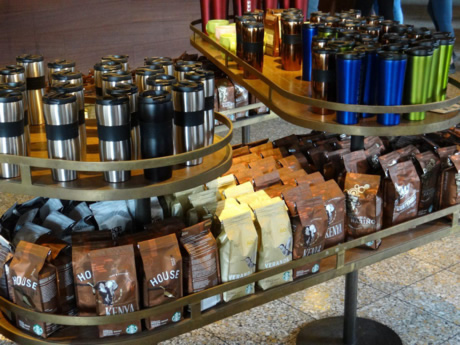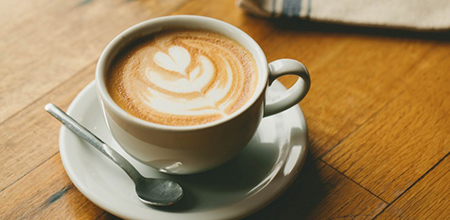The Origin of Coffee

No one can exactly pinpoint when or how the discovery of coffee was made but there are many legends regarding its origin. Coffee is grown around the world but we are able to trace its heritage to the Ethiopian plateau of ancient coffee forests. Legend claims that a goat herder by the name of Kaldi was the first to discover coffee's potential. The tale goes on to explain that Kaldi discovered the many benefits of coffee after he saw his goats consume berries from a tree. They become so energetic that they could not sleep when night fell. After Kaldi reported his discovery to the local monastery abbot, he made a drink utilizing the berries and reported that it kept him alert during the evening prayer's long hours. Once the abbot shared his report with his fellow monks at the monastery, the news of these energizing berries spread like wildfire. When word reached the Arabian Peninsula that a magical berry was discovered, coffee began a long journey that would spread these special beans around the globe.
The trade and cultivation of coffee started on the Arabian Peninsula. Coffee began growing in the Yemeni District of Arabia during the fifteenth century and by the sixteenth century Persia, Turkey, Syria, and Egypt all knew the wondrous benefits of coffee. Houses that publically distributed coffee were known as qahveh khaneh and they began popping up all over the Near East. The popularity of coffee houses took precedence over all beverages and people began frequenting the houses regularly as a social activity.
Patrons of these coffee houses would enjoy their coffee while engaging in conversation, listening to music, watching performers, playing games, and keeping up on relevant news. Coffee houses became the new 'it' place for information exchange and many referred to them as 'schools of the wise'. Each year pilgrims from all over the world visited the city of Mecca by the thousands, and knowledge of these magical beans started to spread.
Near East travelers from Europe returned from their travels telling stories of this dark black and unusual beverage. Coffee finally made its way to Europe by the seventeenth century and was soon a coveted beverage by all. However, at first people were suspicious of the unusual beverage, referring to it as 'Satan's bitter invention'. The local clergy even went as far to condemn the beverage when it first arrived in Venice during 1615. The coffee controversy became so great that an intervention was called on by Pope Clement VII. In order to calm the chaos, Pope Clement VII decided to drink the beverage himself before drawing any conclusions. To the surprise of many, Pope Clement VII was so pleased with the drink that he awarded it a papal approval.
Although many were still skeptical of coffee, coffee houses were rapidly popping up all over England, France, Holland, Austria, and Germany. In England the coffee houses were referred to as 'penny universities' because one could enjoy a cup of coffee and thought provoking conversation for the price of a penny. It was not long before coffee replaced beer and wine as the favored beverage to drink during breakfast hours. People began the day feeling energized and alert instead of drunk which vastly improved work ethic and moral. There were more than three hundred coffee houses in London by the middle of the seventeenth century alone. Many artists, shippers, Merchants, and even like minded brokers frequented these coffee houses. Coffee made its way to New Amsterdam, now known as New York, by the mid 1600s. While the rapid installations of coffee houses continued, tea was still the drink of choice in the New World. However, in 1773 when the colonists opposed King George III's heavy taxation of tea with the revolutionary act of the Boston Tea Party. America's drinking preference would forever be changed to coffee.
Thus, the demand for coffee continually spread like wildfire throughout the world, causing a rise in competition to cultivate coffee in other regions outside of Arabia. The Dutch were not successful in obtaining coffee seedlings until the end of the seventeenth century. Soon after they got their hands on the magical beans, they began to grow and harvest coffee off of the Island of Java located in Indonesia after many unsuccessful attempts of harvesting in India. Coffee thrived in Java, and the Dutch soon had a very productive trade in cultivating coffee. In fact, the Dutch had so much success that they expanded their harvest onto the islands of Celebes and Sumatra.

In 1714, King Louis XIV of France received a coffee plant as a gift from the Mayor of Amsterdam, which he immediately ordered to be planted in Paris at the Royal Botanical Garden. A few years later in 1723, Gabriel de Clieu, a novice naval officer, managed to get himself a seedling from the Royal Botanical garden. After a highly treacherous voyage, Gabriel transported the gift of coffee to Martinique. Coffee thrived in Martinique as well, spreading more than eighteen million coffee trees all over the island in the course of fifty years. This seedling began the cultivation of coffee throughout the Caribbean, Central and South America. Brazilian coffee is now world renowned and owes its fame to Francisco de Mello Palheta. Francisco was called upon by the brazilian emperor to fetch coffee seedlings from the French Guiana. To Francisco's dismay the French did not want to share their precious coffee but he did not give up. Francisco was able to charm the French Governor's wife with his good looks into gifting him with coffee seeds. In an effort to be discreet the French Governor's wife hid the seeds within a large bouquet of flowers. These seedlings were the beginning of Brazil's billion dollar coffee industry.
Many colonists, missionaries, traders, and travelers continuously made efforts to bring coffee's magical beans to new lands. Thus, spreading coffee trees throughout the globe. One could find coffee plantations on the rugged mountaintops of the highlands as well as on the floors of tropical rainforests. Few crops truly flourished leaving many short-lived. Astonishingly enough these magical coffee beans were able to contribute enough to build economies and establish new nations. Many fortunes were built and lost because of these magical beans. Coffee was one of the world's highest profiting export crops by the conclusion of the eighteenth century. Coffee is the world's second most sought after commodity, after crude oil of course (see page "Top Types of Coffee").
